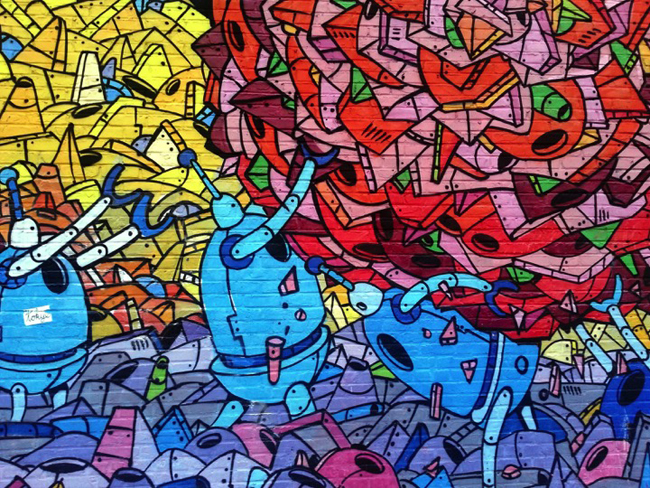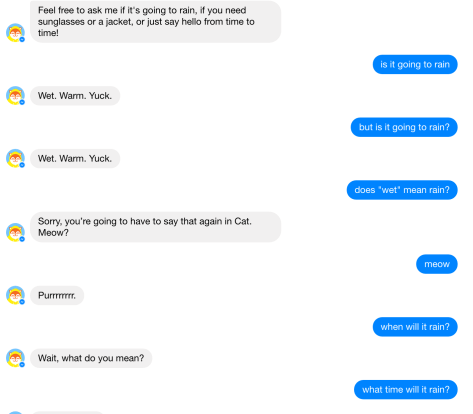
By Margaret Ady
Build a chatbot in a day? Challenge accepted.
Since April, when Mark Zuckerberg announced the launch of Facebook Messenger’s platform, which allows anyone to build custom bots in Messenger, the tech industry has lost its collective mind over bots. As of July 1, there were already 11,000 bots on Facebook Messenger, and a whopping 23,000 developers signed up for its bot engine. Not to mention thousands and thousands of articles covering the bot revolution and how bots will be the death of mobile apps, how they represent the future of customer service, and so on.
To better understand the hype, I decided to build one. And just to make it interesting, I made a bet with a friend that I could create a chatbot in one day (they are supposed to be easy, right?).
The result: mark.ady bot (pronounced mark-ah-dee), a content-driven bot on Facebook Messenger that serves up marketing insights, curates custom travel news based on a user’s interests, and engages in very basic small talk using artificial intelligence (AI).
Here is what I learned in the process of building mark.ady bot:
Chatbots are incredibly simple to create (seriously!)
While one of the key draws of chatbots is that they are easy to create, as a non-developer, I was skeptical. But, with so many tools available to help programming beginners like myself, chatbots really are simple.
There many bot-as-a-service platforms on the market. They each have their pros and cons, so do your research before choosing one. If you are looking to build a bot, but aren’t willing to spend time and budget on development (like me), I highly recommend Chatfuel, a free service that allows you to create bots on Messenger or Telegram with little to no coding knowledge.
The UX is completely dependent on how well your bot interacts with its users
While you can build out technically complex processes and workflows for your bot, the front-end is pretty stripped-down. There are no fancy interfaces. No CSS. No shiny objects. This makes creating bots easier, but it also means that there is nothing to hide behind if you create a a shabby bot.
So how do you end up with an awesome bot? You focus first and foremost on how it interacts with users. Here are some useful tips:
- Be very clear about the purpose of your bot. This will allow you to better anticipate your users’ actions so that you can build a more intuitive bot.
- Even if you think your bot is intuitive, it doesn’t hurt to give users a brief onboarding. Keep in mind that bots are still relatively new, and not everyone knows how to use them.
- Draw out the structure and logic before building your bot. Your building blocks are essentially a ton of conditional “if-then-else” statements, and it helps to see them on paper first.
- Personalize as much as possible (ok, I didn’t do much of this due to time constraints, but you should).
- Use graphics or video to enrich the experience.
- Test your bot! All the workflows should be on point when releasing a bot. Test early and test often to make sure that everything works properly.
Make use of buttons
I know, I know, AI is the ‘cool’ part of bots, especially for all the tech nerds out there. It is easy for us to get carried away with AI, but take a step back and remember why people are actually using bots. It is for ease of use and simplicity; bots are both easier and faster than downloading a new app or navigating a new website.
Likewise, tapping a button is both easier and faster than typing out a sentence in many cases. Buttons also provide explicit inputs back to your bot so that you don’t always have to rely on your bot to interpret user inputs correctly. So, to be easy, fast, and accurate, use buttons whenever possible.
That’s not to say that buttons cover all use cases. There will be instances when you need the user to provide information (e.g. if your bot facilitates a hotel booking), and instances when users just want a chance to talk to your bot. Just be cognizant of each use case and use the function that makes the most sense for your user.
Inject a little personality
You know that guy in the office with the personality of a wet cardboard box? Don’t let your bot be that guy. Create a bot that people actually want to talk to. To do that, there are two key things to consider:
- Your bot’s tone – This is relatively simple. Stick with the tone of your brand when building out your chatbot’s responses. If you stink at writing, recruit your marketing department or hire a copywriter to draft up some snappy messages.
- Your bot’s “brain” – Here is where things get a little more complex. Your bot needs to be able to process user input, and reply with an answer that makes sense, otherwise, it will be extremely frustrating to use. This requires thinking through how your users will communicate with your bot (i.e. natural language processing) so that you don’t end up with something like this:

Final thoughts
I WON THE BET!
In all seriousness, mark.ady bot was developed without many hiccups, thanks in large part to the tool that I used to create it. Is the bot perfect? Certainly not. With more time, there are more functionalities I would want to add and some AI improvements that I would want to make. But it does show how painless it is to create a minimum viable product when entering the world of bots.
As for all the bot hype? I’m excited about the future of bots. While I am not confident that they will kill mobile apps in the near-term future, I do think that, if developed well, bots can provide businesses with a low-cost way to improve customer service, personalize the customer journey, improve marketing, and more. Bring on the bots!



